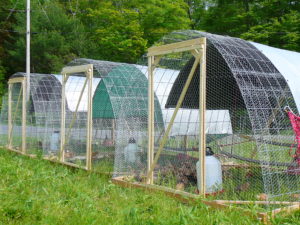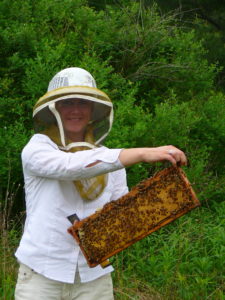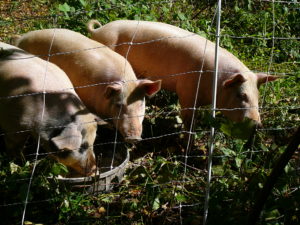Farm Profit: Making a Life and a Living from Your Farm
My husband and I started Shelterbelt Farm in Caroline, NY last year, joining the ranks of new farmers across the country capitalizing on direct marketing opportunities and the demand for local food.
Like most beginning farmers, I’m coming into a farming career from outside the production agriculture sector. I have been working on food and farming education for 14 years, but my experience running a farm business was nearly non-existent. So I had a lot of the same questions as the new farmers who contact me in my role as coordinator of the Northeast Beginning Farmer Project. One of the first questions these new farmers typically ask is “How much profit can I expect my farm to generate?” What they’re really asking is “Will I be able to support myself and my family from my farm income? Would I be able to quit my office job if I chose to?”
I’ve learned from dozens of conversations with farmers that the short answer is maybe. No one will be able to give you a magic formula with a list of crops to grow for the best bottom line. It depends on your scale, location, soil, skills, efficiency, and markets. Ten different farms all growing a similar mix of crops will likely have vastly differing levels of profitability. This was well illustrated in the Grower to Grower:
Creating a Livelihood on a Fresh Market Vegetable Farm study published by the University of Wisconsin in 2006, which followed 19 diversified vegetable farmers over the course of two years, and documented profitability in the form of hourly wages paid to the farm owners. The wages of the farmers studied ranged from $2.26/hr to $14.90/hr for their work. You can find this study online at: http://www.cias.wisc.edu/crops-and-livestock/report-helps-fresh-market-vegetable-growers-understand-and-share-finances/
Your profit potential also depends on what you mean by “profit”, and on your goals.
Three Takes on Profit
For such a simple concept, profit is a surprisingly slippery term.
Most people know that Income – Expenses = Profit. The problem lies in how people use the term. Let’s consider three examples that are laid out as black-and-white; in real life there are more nuances and combinations
Farmer A doesn’t include his own labor as an expense, and may also not include overhead costs, so when he subtracts his expenses from his income, the results for his chicken and strawberry enterprises each look pretty fantastic. He uses these figures to calculate his price, which is significantly lower than his full-time farming neighbors charge for a similar product. He has an off-farm income source with no aspirations to terminate this arrangement. He refers to his farm as being profitable, but his operation wouldn’t stand on its own financially without significant price increases.
Farmer B also doesn’t include her labor as an expense, but she keeps track of her hours invested in each enterprise. Then, when she subtracts expenses from her income, she takes the “profit” that’s left and divides it by the number of hours she put into that enterprise, coming out with an hourly wage for herself. She bases her product prices on the hourly wage she wants to have, and divides her overhead expenses among her mix of enterprises. She culls enterprises that don’t pay her well enough for her time, and is able to support herself full-time on her farm.
Farmer C tracks all his labor and includes a $13/hr wage for himself as part of his expenses ($10/hr + taxes and social security). When planning for profit for any one of his crops, he subtracts all expenses (including his labor and a portion of the farm overhead), and still expects there to be money remaining as profit, which he can use for retirement savings, kids’ college, reinvestment into the farm, or any other purpose. This method of calculating profit reduces the farmer’s risk by ensuring that he could pay someone to take his place should he break a leg or get sick.
None of the examples above is “right” or “wrong”; they can each work for different people. And in fact there is a lot of gray area here: examples B and C overlap in real life. The point is to make sure you understand which type of profit a farmer means when they say “The profit margin on culinary herbs is fantastic” or “We were profitable in our first year.” Most farmers will tell you that it takes 5-9 years to achieve true profitability, though it is possible sooner if you have very low overhead and advanced production skills. And make sure you understand which method of calculating profitability best fits with your farming aspirations.
Farm Goals
Profit doesn’t just happen; you need to plan for it and make it happen. Most farms in the US, regardless of size, have some source of off-farm income, whether by choice or necessity. How your farm fits into your lifestyle and your livelihood—and how much profit it generates to support your family–is up to you.
Like many small farmers, my husband and I started out homesteading, with a desire to produce as much of our family’s food as possible. Now that we are growing into a commercial operation, feeding our family is still a high priority. We know that our farm will need to be profitable—using the Farmer B meaning here—but profit is secondary to our quality of life, like having free time in the winter, eating really good food, working outdoors, and being our own bosses. We will probably always have an off-farm income source, by choice, as my husband loves his carpentry work, so there are some things (like health insurance and retirement savings) that we don’t necessarily expect the farm to provide.
Other farmers meticulously plan their operations to generate the greatest possible profit. Richard Wiswall points out in The Organic Farmer’s Business Handbook that it is entirely possible to make a living on a small farm that is competitive with doctors’ or lawyers’ salaries. You can earn enough to fund your retirement and to put your kids through college. You can do this and also still have some of the quality of life benefits mentioned above. But you must be devoted to the focus on profit; persistently culling crops or animals that don’t meet your profit goals, gaining efficiencies and cutting costs that aren’t essential. If you are not willing to put in that kind of intensive management work and focus on return-on-investment, you can still make a living on your farm, but you’ll likely still need some off-farm income.
Conclusion
Despite popular thinking, farming can be enormously profitable. Why shouldn’t it be? Producing food for people is a critical community service that requires no less skill than doctors or computer programmers possess.
Still, an important role for an ag service provider is to ensure that first-generation beginning farmers don’t enter this profession too starry-eyed. It’s especially important for a new farmer to understand that just because she saw local organic chicken fetching $6/lb or meslun mix at $18/lb at the farmers market doesn’t mean that those farmers are getting rich. More likely it means that they have done a full accounting of their farming costs and have set prices that will cover these costs and also pay themselves a “livable” wage (which may still be quite low).
Be clear on your goals, have a good understanding of your costs, and set your prices accordingly. With a bit of skill and luck, you’ll be able to achieve your farm profit goals and make a good life on the farm for you and your family.





Very useful article!
Seems like keeping active records on a mobile deice could enable better real time decision making and keep track of the true cost of all our farming enterprises.
there’s no running away from the numbers
I have been running a business for 30 years and we have divided our work into profit centers. Some of the profit centers are doing well and others are not doing as well. When we combine everything together the business is in good shape but when we allocate the businesses expenses equitably to our profit centers it is obvious that some aspects of the business are more profitable. We never want to have all of our eggs in one basket so even though some are more profitable we know that diversifying our income sources is the best strategy. I liked the idea that outside the farm income is still available
I don’t think that the consumer should have to subsidize any business that is not well run but running a small farm is not like a typical businesses. There are incredible often unmanageable risks associated with weather, pests,etc. and the lack of a fully developed local demand (local institiutional demand is just a fraction of what it could potentially be; grocery stores carry so little local produce etc; big distributors don’t cater to the local producer and the smaller distributors are not always able to meet demand from customers who might want to buy local but also want convenience and much more.) So how do we change the system so that a farmer without financial resources to dip into doesn’t have to live on starvation wages? There are so many pieces of the puzzle that need fixing.
It would appear that transitioning from a hobby farm to a small business (for potential retirement income/kid’s college expenses) is achievable if you understand and are willing to have extreme amounts patience and persistence. Many of the topics revolve around a slow and steady approach that requires patience and a lot of trial and error. As you often hear Farmers often have to make difficult decisions and constantly adapt to changing plans or crop/livestock based on your area, land, Mother Nature and experience. Farmers absolutely must be flexible and generally need to be willing to take risks, in order to learn and grow. If these are NOT traits that you are willing to embrace, then you will have a difficult time meeting your “profitability” goals.
My plan was to “transition” from nursing to ranching on a gradual basis and from what I read that seems like a wise way to go. Luckily, I already owned my land so that expense is covered but I am getting the idea that’s its best not to put all you eggs in one income basket. But if your willing to put sweat equity into it and are willing to get dirty in the heat and sleet it has its rewards. While I’m dreading making ” rookie” mistakes that can cost me financially, I am cautiously optimistic about ranching half to 3/4 full time.
This article really helped me gauge the kind of depth that farming for profit can endure. I honestly never would have even thought of my own laboring as a cost or an expense, which the article also mentions most farmers don’t, this is something I haven’t even considered with my regular small business. This is truly helpful because in whatever manner I decide to sell my production, this can be an insightful way to think of an equative formula.
It’s interesting how different all three farmers defined “profit.” Since we are preparing to establish our homestead whose primary purpose is to meet our family’s food and lifestyle goals, we aren’t as focused on monetary profits at this point. That said, we do plan to sell some of the products we produce on our farm/homestead and it is helpful to consider these things. One thing I often find missing from what we consider profit are the mental/physical/spiritual health benefits from working outdoors, eating wholesome, clean food, and getting loads of physical exercise (think of the gym membership savings!). These things are very profitable too!
Your statement “One thing I often find missing from what we consider profit are the mental/physical/spiritual health benefits from working outdoors, eating wholesome, clean food, and getting loads of physical exercise.” is so deep and true.
I appreciate it and do live by it. Thank you for sharing this.
I am just reviewing some of the course content from this past fall.
Very helpful article. I learned a lot from this – thank you for sharing!
I did not take my pottery business seriously. I was mostly just trying to cover costs. I never wanted it to be my job, or my life. But that’s exactly why this is different. I didn’t account for labor, I barely even accounted for supplies. Just whatever I could squeak out of anyone willing to spend their hard earned money on my handcrafted goods was good enough. That mentality simply will not do. I want my farm to not only be sustainable but to sustain me, and my family, and my community to the highest degree of stewardship that I can manage. I’m not much a planner by nature but if I’ve learned anything in the last few decades it’s that I am capable of tremendous transformation.
its seems important to understand how to measure your individual success. Having off farm income or multiple streams of income, in my case seems like the way to go, but won’t know until I find out what my overhead will be.
Am interested in finding statistics and studies relating to “how many years to make farm startup profitable”. Separately and specifically, also interested also in
olive oil production and tree nurseries. Any suggestions/research leads would be most appreciated.
Thanks for sharing information. Wish to see much more like this.
great article with realistic expectations and the different accounting methods of profitability.
I have been farming on my own for three years and continue to support my family with off farm work. I would like to make the move to full time as I can see that my profits have been limited by the amount of product I produce, which is directly related to the hours I put in on weekends and after work.
Amazing overview and insights. I am even more determined and eager to learn and practice what I have been reading about. I have no objections or qualms toward farming or ups and downs there is. After all, history shows and tells us how successful farmers before us thrived and survived. Today, we have too many resources and information not to succeed. The question lies with the person and their will.
I am ready and always willing to see the fruits of my labor.